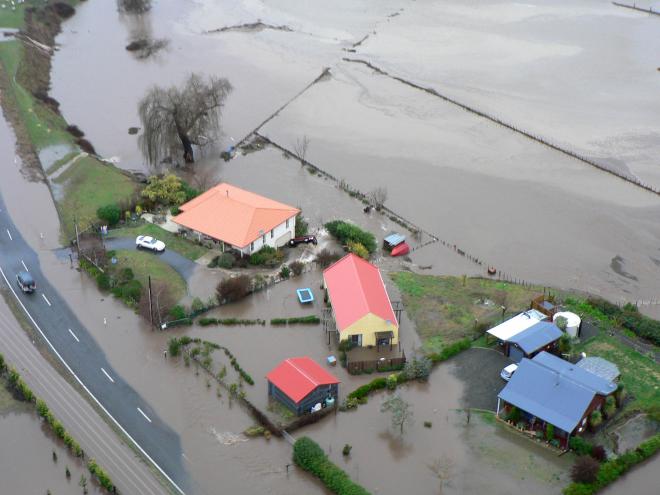GPUs power up desktop flood modelling
The Challenge:
Coastal inundation models predict how future weather events may damage property and endanger lives. But these models are computationally expensive. Private and public consultants without HPC access must use lower-resolution, less reliable models.The Solution:
NIWA researchers aimed to find a more efficient way to use coastal inundation models. They compared the XBeach numerical model on CPUs and GPUs. Applying the model to GPUs involved translating the code for the new hardware.The Outcome:
Using the Māui supercomputer, CSIRO resources and NIWA computers, Dr Christo Rautenbach and Dr Cyprien Bosserelle have demonstrated the efficiency of GPU inundation modelling. They found that desktop GPUs could compete with HPC CPU clusters in processing speed and efficiency.
Coastal inundation describes when sea water rises to endanger infrastructure and people’s safety. Phenomena like tides, waves and storm surges drive this inundation. Being able to accurately model inundation events can lead to resilience planning by governments and industry. This can protect property and lives. But models need to incorporate complex physical processes that challenge computing resources.
Dr Christo Rautenbach is a Coastal and Estuarine Physical Processes Scientist at NIWA. He used NeSI’s Māui supercomputer in a series of capability tests for the XBeach coastal inundation 2-D modelling.
He was part of a team who tested the XBeach model against three criteria: speed-up ratio, time-saving ratio and computational efficiency. He compared the use of GPUs and CPUs ranging, from desktops to high performance computers.
Speed-up ratio is a comparison between a simulation’s time when run on a single-core computer compared to a multi-core computer. It measures how well parallel processing speeds up the simulation’s run-time. The time-saving ratio is this figure converted to a number between zero and one.
“One underlying aim is we're trying to tell the coastal modelling community, because that's our community, let's translate more packages to GPUs. This was a case study to show the potential; to show the speed up that we can potentially get.”
While the modelling program was the same, XBGPU was a translation of the code to apply the program to GPUs. This was achieved in previous years by a team lead by NIWA’s Dr Cyprienne Boserelle.
To compare GPU capability to CPUs, Christo’s team ran XBeach on two Australian CSIRO CPU clusters, three standard computers with teraFLOPS capability, and NeSI’s A100 and Tesla P100 tensor cores.
Christo found, when running XBeach on CPUs, the speed-up ratio plateaued beyond 30 cores. With GPUs, NeSI’s A100 had a 15 times greater relative speed-up ratio using XBGPU than a 1.39 teraFLOPS desktop. The research showed that GPUs were much more efficient than CPUs when running XBeach modelling software. So much so, that powerful desktop GPUs can compete with HPC CPU resources.
“I worked in civil engineering and engineering consultancies for a large chunk of my career. And the problem we always had there is civil and private institutions don't have access to supercomputers yet need to compete with HPC capability.”
“Suddenly engineers outside of research institutes can look at this and say, ‘if we just translate our existing software to GPU capabilities, we can actually produce computations to the tune of a 160-core CPU machine, which we will never be able to maintain or afford.’”
As well as enabling Christo’s research, this was a pilot study for applying the NeSI’s A100 nodes to numerical modelling. The high level of computational efficiency and speed demonstrated in the project proved the A100 is an excellent resource for GPU-based numerical modelling.
“Most of my work in South Africa was trying to get around those [computational] constraints, just being smart about how we can do more with less power. Coming to New Zealand, and with NeSI at my front door, the amount of research questions I can consider is exponentially greater.”
Christo’s team are looking at applying this methodology of speeding up simulations using GPUs to other numerical models. It has the potential to greatly improve high-resolution modelling using HPC resources and shows the benefits of the Māui supercomputer and its A100 nodes compared to CPU-based HPC nodes.
The XBGPU can be applied to civil engineering consultancy, local planning and, on the high-resolution scale, more accurately predict future coastal inundation events around New Zealand and the world.
“We wanted to run different future scenarios for Wellington, based on past at storms and coastal inundation.”
A government-funded Deep South Challenge report in 2020 projected sea rise to increase by at least 10 cm by 2040. This will lead to10,000 New Zealand homes becoming uninsurable and millions of dollars in damage. Accurately predicting future coastal inundation is vital to protecting homes and lives in these changing conditions.
Christo’s work could make predictions cheaper and faster. It also showcases NeSI’s capabilities in numerical modelling and how our partnerships advance New Zealand science and protect citizens.
Do you have an example of how NeSI platforms or support advanced your research? We’re always looking for projects to feature as a case study. Get in touch by emailing support@nesi.org.nz.







